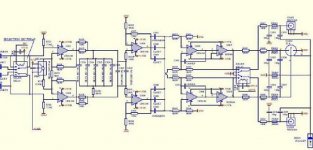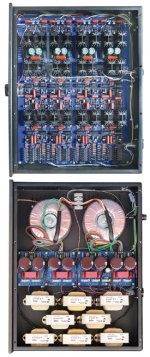I discussed a lot the Allen Wright about his single components, balanced RIAA. He was of the opinion that a balanced double RIAA could make cancelation of micro detail when the signal is put together again. In a fully balanced system that would be in the loudspeaker.
I am now in the position to test this theory. The Rauschfrei can be configured in such a way that it works balanced at the input and can be switched to unbalanced by connecting pin 1 to pin 3. This way we can compare balanced to unbalanced quite convenient. In the unbalanced case the negative portion of the circuit is shunted to ground so does not contribute to amplification. I played this to Audio professionals like Ward Maas, Martina Schöner, Karl-Heinz Fink et.all. in several different systems of very high quality. All preferred the balanced option. I got comments like : more open, more dimensional, more transparent etc. so the opposite of the theorized problems. Prerequisite is of cause accurate relative matching of the RIAA components. I test this with a differential scope
and generate mathematically the sum. I use a 1kHz square wave shaped with an anti RIAA. I can publish some screen shots from the lab next week, i am on tour this week so please give me some time.
I am now in the position to test this theory. The Rauschfrei can be configured in such a way that it works balanced at the input and can be switched to unbalanced by connecting pin 1 to pin 3. This way we can compare balanced to unbalanced quite convenient. In the unbalanced case the negative portion of the circuit is shunted to ground so does not contribute to amplification. I played this to Audio professionals like Ward Maas, Martina Schöner, Karl-Heinz Fink et.all. in several different systems of very high quality. All preferred the balanced option. I got comments like : more open, more dimensional, more transparent etc. so the opposite of the theorized problems. Prerequisite is of cause accurate relative matching of the RIAA components. I test this with a differential scope
and generate mathematically the sum. I use a 1kHz square wave shaped with an anti RIAA. I can publish some screen shots from the lab next week, i am on tour this week so please give me some time.
I thought that Arthur Loesch was the first one that used a Fet-Tube cascode as MC input.
In the latest Tempo phonostage there is only a WE417 at the input so i may be wrong. Yes, the other Lösch ( Thorsten ) has a Fet-Tube cascode in his Toccata.
The Rauschfrei cabinet is in part made by Modushop and in part in Germany and the Netherlands. I found the Modushop front and back plate not of sufficient quality for a piece like this.
In the latest Tempo phonostage there is only a WE417 at the input so i may be wrong. Yes, the other Lösch ( Thorsten ) has a Fet-Tube cascode in his Toccata.
The Rauschfrei cabinet is in part made by Modushop and in part in Germany and the Netherlands. I found the Modushop front and back plate not of sufficient quality for a piece like this.
conceptual schematic
RIAA part (1st setup, not the final revision)
Attachments
This is exactly what i experienced because of poor quality ofI found the Modushop front and back plate not of sufficient quality for a piece like this.
material and workmanship.
After rejecting front and backplate there aint much left for
the price you payed....🙁
And not mentioned the screws made of chewing gum.
I found an interesting circuit by JC Morrison that is a Fet-Tube folded cascode. It can be used as an input stage for an MC pre-pre. He claims that it sounds better ( less Hifi, better for classical ) then a series Fet-tube cascode ( Arthur Loesch circuit for example ). He reasons that the idle current can be set more optimally and independently in the Fets and the tubes. Running a series Fet-Tube cascode on 35mA would certainly cause some trouble and lots of heat. With 200V that would burn 7W.
Tube amplifiers for high-end audio by The David Berning Company
Very similar,
Reinhard
hey all, just a quick comment... arthur loesch did test a 2SK146 + 417A cascode, but much as i did, and others as well, didn't really love the flavor. that is what i remember. it's a timbrel thing... straight up cascode tends to "brighten" or add a little "glare", to borrow poor visual metaphors for something you hear... even when the total distortion is very low, which it clearly can be with the hybrid cascode. i think JFET cascodes do the same thing. balanced small signal stuff, even triode, that cancels the low even order harmonics, also does this. the favoring of the odds lends an exciting "zing" that isn't great for all kinds of music. dense stuff and noisy stuff really rings that bell in a tiresome manner. arthur stuck with the triode first, and never gave up on it. that JFET/triode cascode wasn't arthur's...
i myself didn't take cascode seriously until i started using constant current loading with it. depending on the load, it was then possible to "shape" the spectrum back into a more "gaussian" distribution of the harmonic distortion: 2nd, then 3rd, etc.... the timbre is never normal when the odds are in the same magnitude.
we are of course talking about open loop designs. it's quite a bit different with feedback designs. and the difference between the two is like the difference between japanese food and traditional french. both can be delicious, but for such different reasons!
noise is of course a big factor and there is no way the triode front end for MC can compete with solid state, or hybrid. a good transformer in front can make that more equal, but the transformer becomes a significant ingredient. using the high Gm VHF triode as a first step has been proven to work delightfully, but you do have to live with the rush. for me, it is still the reference. whatever one does, it needs to attempt to reach that quality... but improve the noise and distortion performance. but this is a very opinionated niche perspective. who really cares except for a few whacky maniacs, such as those who hang out here!
who's going to etf?
i myself didn't take cascode seriously until i started using constant current loading with it. depending on the load, it was then possible to "shape" the spectrum back into a more "gaussian" distribution of the harmonic distortion: 2nd, then 3rd, etc.... the timbre is never normal when the odds are in the same magnitude.
we are of course talking about open loop designs. it's quite a bit different with feedback designs. and the difference between the two is like the difference between japanese food and traditional french. both can be delicious, but for such different reasons!
noise is of course a big factor and there is no way the triode front end for MC can compete with solid state, or hybrid. a good transformer in front can make that more equal, but the transformer becomes a significant ingredient. using the high Gm VHF triode as a first step has been proven to work delightfully, but you do have to live with the rush. for me, it is still the reference. whatever one does, it needs to attempt to reach that quality... but improve the noise and distortion performance. but this is a very opinionated niche perspective. who really cares except for a few whacky maniacs, such as those who hang out here!
who's going to etf?
that "patent" really cracks me up... as if the differences between a tube cascode or a JFET cascode were fundamentally different in operation or principle. the patent system is broken. it needs to be thrown in the crapper.
> I found the Modushop front and back plate not of sufficient quality for a piece like this.
Joachim,
You have seen the stuff we did for Jan in real.
You know how to get in touch if you want mechanical parts.
Jan already asked us for you and I said yes.
Personalised service only for friends.
😉
http://www.diyaudio.com/forums/pass-labs/183362-f5x-euvl-approach-10.html#post2738556
Patrick
Joachim,
You have seen the stuff we did for Jan in real.
You know how to get in touch if you want mechanical parts.
Jan already asked us for you and I said yes.
Personalised service only for friends.
😉
http://www.diyaudio.com/forums/pass-labs/183362-f5x-euvl-approach-10.html#post2738556
Patrick
i myself didn't take cascode seriously until i started using constant current loading with it. depending on the load, it was then possible to "shape" the spectrum back into a more "gaussian" distribution of the harmonic distortion: 2nd, then 3rd, etc.... the timbre is never normal when the odds are in the same magnitude.
using the high Gm VHF triode as a first step has been proven to work delightfully, but you do have to live with the rush. for me, it is still the reference. who's going to etf?
Hi nanana
Agree with you regarding the "gaussian" armonic distortion distribution.
What is a Gm VHF triode ? why do you need to live with "the rush" ?
What is etf ?
Sorry for the load of question marks, but that is how I normally get there 🙂
large external power supply using caps and chokes.
As good as identical to the CPS (/P) power supply of Mr Norbaek's LX preamp.
ahhh, forgive my assumptions....
Gm is the vacuum tube era's symbolic expression for transconductance. VHF is "very high frequency", from the old radio standard of up to 250 MHz. and "rush" is the amplified mix of johnson, flicker and 1/f noise that you hear in a tube preamp working with a signal level of under 1mV, or so.
Gm is the vacuum tube era's symbolic expression for transconductance. VHF is "very high frequency", from the old radio standard of up to 250 MHz. and "rush" is the amplified mix of johnson, flicker and 1/f noise that you hear in a tube preamp working with a signal level of under 1mV, or so.
Last edited:
That was an LA Audio Pre-Pre with tubes. It sounds nice and cozy but can not compete in transparency and dynamics with something like the Suesskind. I keep it though as a benchmark.
Any details about the Suesskind PSU ?

